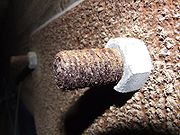
Rusty bolt effect
Encyclopedia

Diode
In electronics, a diode is a type of two-terminal electronic component with a nonlinear current–voltage characteristic. A semiconductor diode, the most common type today, is a crystalline piece of semiconductor material connected to two electrical terminals...
. (This is the same effect that early radio receivers, known as crystal sets, used to demodulate the radio signal.) This gives rise to undesired interference, including the generation of harmonics and/or intermodulation
Intermodulation
Intermodulation or intermodulation distortion is the amplitude modulation of signals containing two or more different frequencies in a system with nonlinearities...
. Rusty objects that should not be in the signal-path, including antenna structures, can also reradiate radio signals with harmonic
Harmonic
A harmonic of a wave is a component frequency of the signal that is an integer multiple of the fundamental frequency, i.e. if the fundamental frequency is f, the harmonics have frequencies 2f, 3f, 4f, . . . etc. The harmonics have the property that they are all periodic at the fundamental...
s and other unwanted signals. As with all out-of-band noise, these spurious emission
Spurious emission
A spurious emission is any radio frequency not deliberately created or transmitted, especially in a device which normally does create other frequencies...
s can interfere with receivers.
This effect can cause radiated signals out of the desired band, even if the signal into a passive antenna is carefully band-limited. If one experiences this problem, one should check both the transmitter and the television for dirty connections or corroded parts. One should also check for signs of corrosion
Corrosion
Corrosion is the disintegration of an engineered material into its constituent atoms due to chemical reactions with its surroundings. In the most common use of the word, this means electrochemical oxidation of metals in reaction with an oxidant such as oxygen...
in the cables which link the equipment to the antennae and for badly made joints. Beyond this, one might check any metal objects near the antenna for rust
Rust
Rust is a general term for a series of iron oxides. In colloquial usage, the term is applied to red oxides, formed by the reaction of iron and oxygen in the presence of water or air moisture...
or corrosion. Any of these could be the source of the problem.
It is possible to cure this problem in several ways:
- Remove the corroded object. This is often the best cure because if you can eliminate the object then the interference it generates will cease entirely.
- Clean the object - if the rust is superficial, the diode behavior might be eliminated by removing the surface rust.
- Place an insulatorElectrical insulationthumb|250px|[[Coaxial Cable]] with dielectric insulator supporting a central coreThis article refers to electrical insulation. For insulation of heat, see Thermal insulation...
between the two objects which are making the rust bolt. This might reduce the RF current. - Lower the RF field strength. Intermodulation becomes much worse with amplitude, so small amplitude reduction can greatly reduce the intensity of the effect. See the mathematics section below for details.
- Get a better antenna which is more directionalDirectional antennaA directional antenna or beam antenna is an antenna which radiates greater power in one or more directions allowing for increased performance on transmit and receive and reduced interference from unwanted sources....
. It may be possible to point the aerial in such a direction that it does not pick up the unwanted signal coming from the "rusty bolt."
Mathematics associated with the rusty bolt
The transfer characteristicTransfer function
A transfer function is a mathematical representation, in terms of spatial or temporal frequency, of the relation between the input and output of a linear time-invariant system. With optical imaging devices, for example, it is the Fourier transform of the point spread function i.e...
of an object can be represented as a polynomial:

Or, taking only the first few terms (which are most relevant),

For an ideal perfect linear object K2, K3, K4, K5 etc are all zero. A good connection approximates this ideal case with sufficiently small values.
For a 'rusty bolt' (or an intentionally designed frequency mixer
Frequency mixer
In electronics a mixer or frequency mixer is a nonlinear electrical circuit that creates new frequencies from two signals applied to it. In its most common application, two signals at frequencies f1 and f2 are applied to a mixer, and it produces new signals at the sum f1 + f2 and difference f1 -...
stage), K2, K3, K4 and/or K5 etc are not zero. These higher-order terms result in generation of harmonics.
The following analysis applies the polynomial representation to an input sine-wave.
Harmonic generation
If the incoming signal is a sine wave {Ein sin(ωt)}, (and taking only first-order terms), then the output can be written:
Clearly, the harmonic terms will be worse at high input signal amplitudes, as they increase polynomially with the amplitude of Ein.
Mixing product generation
Second order termsTo understand the generation of nonharmonic terms (frequency mixing
Frequency mixer
In electronics a mixer or frequency mixer is a nonlinear electrical circuit that creates new frequencies from two signals applied to it. In its most common application, two signals at frequencies f1 and f2 are applied to a mixer, and it produces new signals at the sum f1 + f2 and difference f1 -...
), a more complete formulation must be used, including higher-order terms. These terms, if significant, give rise to intermodulation distortion.


Third order terms




Hence the second order, third order and higher order mixing products can be greatly reduced by lowing the intensity of the original signals (f1, f2, f3, f4 ...... fn)

